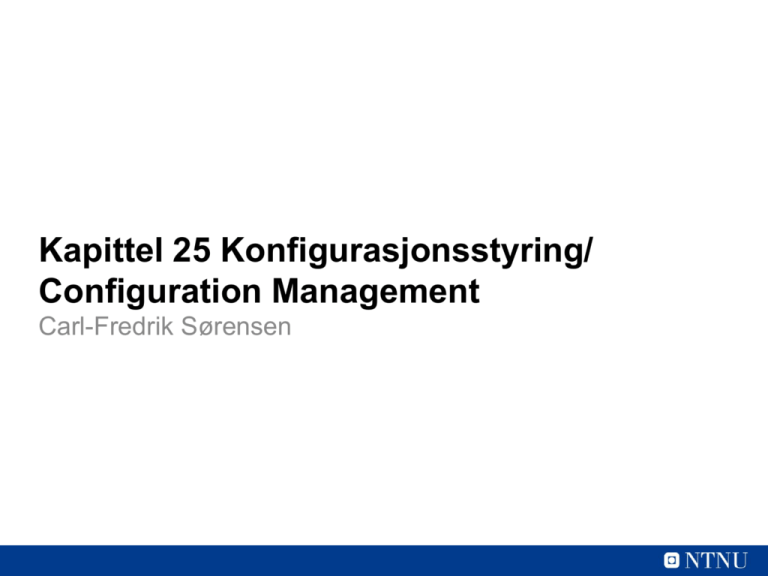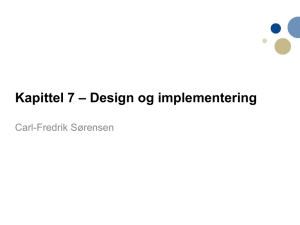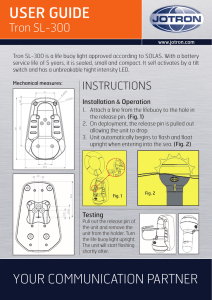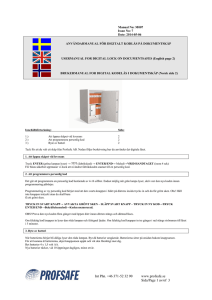Configuration Management
advertisement

Kapittel 25 Konfigurasjonsstyring/ Configuration Management Carl-Fredrik Sørensen Referanser • Kapittel 25 – Configuration Management • Lysark fra Sommerville, Letizia Jaccheri • Project Configuration Management http://youtu.be/lvVvMmspMYk IIT Prof.Shashi Kelkar 2 Tema for forelesning • • • • Versjonskontroll (1) Bygging av systemer (2) Endringskontroll (3) Release håndtering (senere forelesning) CM • Spesifikasjon • Utvikling • Validering • Evolusjon 3 Konfigurasjonsstyring • Programvare endres ofte. Systemer kan oppfattes som et sett av versjoner hvor hver må bli vedlikeholdt og styrt. • Versjoner implementerer endringsforslag, feilkorreksjoner og tilpasninger til forskjellige maskinvare og operativsystemer. • Konfigurasjonsstyring (CM) omhandler politikker, prosesser og verktøy for å håndtere programvare og relatert dokumentasjon som er under endring. • CM fordi det er vanskelig å holde kontroll på hvilke endringer og komponentversjoner som har blitt inkludert i hver systemversjon. 4 CM aktiviteter • Endringskontroll – Holde orden på endringsønsker fra kunder og utviklere. Utarbeide kostnader og innvirkning på endringer, og avgjøre hvilke som skal bli implementert. (Jira) • Versjonskontroll – Holde orden på de mange versjoner av systemkomponenter og forsikre at endringer gjort på komponenter av forskjellige utviklere, ikke kolliderer med hverandre. (Git, Subversion) • Bygging av systemer – Prosessen med å sette sammen programkomponenter, data og biblioteker og så kompilere disse til å skape et kjørbart system. • Release management – Forberede programvare for ekstern utgivelse og holde orden på systemversjoner som har blitt utgitt for kundebruk. 5 Aktiviteter i konfigurasjonsstyring 6 CM terminologi Term Explanation Configuration item or Anything associated with a software project (design, code, test data, software configuration document, etc.) that has been placed under configuration control. item (SCI) There are often different versions of a configuration item. Configuration items have a unique name. Configuration control The process of ensuring that versions of systems and components are recorded and maintained so that changes are managed and all versions of components are identified and stored for the lifetime of the system. Version An instance of a configuration item that differs, in some way, from other instances of that item. Versions always have a unique identifier, which is often composed of the configuration item name plus a version number. Baseline A baseline is a collection of component versions that make up a system. Baselines are controlled, which means that the versions of the components making up the system cannot be changed. This means that it should always be possible to recreate a baseline from its constituent components. Codeline A codeline is a set of versions of a software component and other configuration items on which that component depends. 7 CM terminologi Term Explanation Mainline A sequence of baselines representing different versions of a system. A version of a system that has been released to customers (or other users in an organization) for use. A private work area where software can be modified without affecting other developers who may be using or modifying that software. The creation of a new codeline from a version in an existing codeline. The new codeline and the existing codeline may then develop independently. The creation of a new version of a software component by merging separate versions in different codelines. These codelines may have been created by a previous branch of one of the codelines involved. The creation of an executable system version by compiling and linking the appropriate versions of the components and libraries making up the system. Release Workspace Branching Merging System building 8 Versjonskontroll /management • Versjonskontroll (VM) er prosessen med å holde orden på forskjellige versjoner av programvarekomponenter eller konfigurasjonsenheter (CI) og systemene hvor disse komponentene blir benyttet. • Forsikre at endringer gjort på disse versjonene av forskjellige utviklere, ikke kolliderer med hverandre. • Versjonskontroll kan være prosessen med å håndtere codelines og baselines. 9 Codelines og baselines Endring CI versjon 10 Codelines og baselines • En codeline er en sekvens av versjoner av kildekode hvor senere versjoner i sekvensen er utledet av tidligere. – Codelines benyttes normalt systemkomponenter slik at det er forskjellige versjoner av hver komponent. • En baseline er en definisjon av et spesifikt system. – Baseline spesifiserer komponentversjonene som er inkludert i et system + en spesifikasjon av biblioteker benyttet, konfigurasjonsfiler osv. 11 Baselines • Baselines kan bli spesifisert vha. et konfigurasjonsspråk (som XML), som tillater at det defineres hvilke komponenter som er inkludert i en versjon av et spesifikt system. • Baselines er viktige siden det ofte er behov for å gjenskape en spesifikk versjon av et komplett system. – En produktlinje kan bli instansiert slik at det er individuelle systemversjoner for forskjellige kunder. – Behov for gjenskaping hvis kunden har rapportert om feil i deres system. 12 Systemer for versjonskontroll • Versjons- og releaseidentifisering – Håndterte versjoner er tilordnet identifikatorer når de blir lagt inn i systemet. • Lagringshåndtering – For å redusere lagringsplass påkrevd av mange versjoner av komponenter med små differanser, tilbys det vanligvis fasiliteter for lagringshåndtering – CI + differanse (endre, slette, legge til). • Oppføring av endringshistorie – Alle endringer til systemkoden eller komponenten er oppført og listet.. 13 Systemer for versjonskontroll • Uavhengig utvikling – Systemet holder orden på komponenter som har blitt sjekket ut for editering og forsikrer at endringer i en komponent fra flere utviklere ikke kolliderer. • Prosjektstøtte – System kan støtte utvikling på tvers av flere prosjekter som deler komponenter. 14 Sjekk-inn og sjekk-ut fra et versjonssystem Independent Development By different devs Change history Storage management 15 Storage management using deltas 16 Codeline grener • Kan være mange uavhengige sekvenser av versjoner på en komponent over tid. – Normalt i systemutvikling hvor forskjellige utviklere jobber uavhengig på forskjellige versjoner av kildekoden og kan endre den på forskjellige måter. • Kan bli nødvendig å flette grener for å lage en ny versjon som inkluderer alle endringer. – Hvis endringer involverer forskjellige deler av koden, så kan prosessen gjøres automatisk ved å kombinere deltaer som er lagt til koden. 17 Branching and merging Add functions Add functions 19 Systembygging • Systembygging er prosessen å lage komplette, kjørbare systemer ved å kompilere og lenke komponenter, eksterne bibliotek, konfigurasjonsfiler osv. • Verktøy for systembygging og versjonskontroll må kommunisere siden byggeprosessen involverer å sjekke ut komponentversjoner. • Konfigurasjonsbeskrivelsen som blir brukt til å identifisere en baseline er også benyttet av verktøy for systembygging. 21 Byggeplattformer • Utviklingssystemet: kompilatorer, kildekodeeditorer osv. (Eclipse). – Utviklere sjekker ut kode fra versjonskontrollsystemet et til et privat område før det gjøres endringer. • Byggeserveren: bygger endelige, kjørbare versjoner av systemet. – Utviklere sjekker inn kode til versjonskontrollsystemet et før bygging. – Systemet som bygges kan avhenge av eksterne biblioteker som ikke er inkludert i versjonskontrollsystemet et. • Målsystemmiljø: Plattformen hvor systemet kjører. 22 Utvikling, bygging, og målplattformer 23 System building 24 Agile: Kontinuerlig integrasjon 25 Endringskontroll • Behov og krav fra forretningen gjennom livsløpet til et system, feil som må rettes og systemer som må tilpasse seg endringer i kjøremiljø. • Endringskontroll er påtenkt å forsikre at systemevolusjon er en styrt prosess og at prioritet er gitt til de viktigste og mest kostnadseffektive endringene. • Prosessen for endringshåndtering omhandler å analysere kostnader og fordeler med foreslåtte endringer, godkjenne endringer som er verdifulle og holde oversikt over endrede komponenter. 26 Prosess for endringskontroll 27 A partially completed change request form (a) Change Request Form Project: SICSA/AppProcessing Number: 23/02 Change requester: I. Sommerville Date: 20/01/09 Requested change: The status of applicants (rejected, accepted, etc.) should be shown visually in the displayed list of applicants. Change analyzer: R. Looek Analysis date: 25/01/09 Components affected: ApplicantListDisplay, StatusUpdater Associated components: StudentDatabase 28 A partially completed change request form (b) Change Request Form Change assessment: Relatively simple to implement by changing the display color according to status. A table must be added to relate status to colors. No changes to associated components are required. Change priority: Medium Change implementation: Estimated effort: 2 hours Date to SGA app. team: 28/01/09 CCB decision date: 30/01/09 Decision: Accept change. Change to be implemented in Release 1.2 Change implementor: Date of change: Date submitted to QA: QA decision: Date submitted to CM: Comments: 29 Faktorer i endringsanalyse • • • • • 30 Konsekvenser ved å ikke gjøre endring Fordeler med endring Antall brukere påvirket av endring Kostnad med å gjøre endring Syklus for produktrelease Questions • How do you judge effectiveness of Configuration Management? – By the numbers of defects reported due to incorrect configuration management • CM is an umbrella activity during development and operation (True or False?) – True • CM plan is not part of project planning (True or False) – False – it is very important to plan for CM • source code files, requirements documents, acceptance criteria, models, test cases, external libraries are CI’s that must be versioned (True or False) – False, not external libraries 31 Kapittel 25 – Mer om konfigurasjonsstyring / Configuration Management Ian Sommerville Build system functionality • • • • • • • 33 Build script generation Version management system integration Minimal re-compilation Executable system creation Test automation Reporting Documentation generation Minimizing recompilation • Tools to support system building are usually designed to minimize the amount of compilation that is required. • They do this by checking if a compiled version of a component is available. If so, there is no need to recompile that component. • A unique signature identifies each source and object code version and is changed when the source code is edited. • By comparing the signatures on the source and object code files, it is possible to decide if the source code was used to generate the object code component. 34 File identification • Modification timestamps – The signature on the source code file is the time and date when that file was modified. If the source code file of a component has been modified after the related object code file, then the system assumes that recompilation to create a new object code file is necessary. • Source code checksums – The signature on the source code file is a checksum calculated from data in the file. A checksum function calculates a unique number using the source text as input. If you change the source code (even by 1 character), this will generate a different checksum. You can therefore be confident that source code files with different checksums are actually different. 35 Timestamps vs checksums • Timestamps – Because source and object files are linked by name rather than an explicit source file signature, it is not usually possible to build different versions of a source code component into the same directory at the same time, as these would generate object files with the same name. • Checksums – When you recompile a component, it does not overwrite the object code, as would normally be the case when the timestamp is used. Rather, it generates a new object code file and tags it with the source code signature. Parallel compilation is possible and different versions of a component may be compiled at the same time. 36 Agile building • Check out the mainline system from the version management system into the developer’s private workspace. • Build the system and run automated tests to ensure that the built system passes all tests. If not, the build is broken and you should inform whoever checked in the last baseline system. They are responsible for repairing the problem. • Make the changes to the system components. • Build the system in the private workspace and rerun system tests. If the tests fail, continue editing. 37 Agile building • Once the system has passed its tests, check it into the build system but do not commit it as a new system baseline. • Build the system on the build server and run the tests. You need to do this in case others have modified components since you checked out the system. If this is the case, check out the components that have failed and edit these so that tests pass on your private workspace. • If the system passes its tests on the build system, then commit the changes you have made as a new baseline in the system mainline. 38 Daily building • The development organization sets a delivery time (say 2 p.m.) for system components. – If developers have new versions of the components that they are writing, they must deliver them by that time. – A new version of the system is built from these components by compiling and linking them to form a complete system. – This system is then delivered to the testing team, which carries out a set of predefined system tests – Faults that are discovered during system testing are documented and returned to the system developers. They repair these faults in a subsequent version of the component. 39 Change management and agile methods • In some agile methods, customers are directly involved in change management. • The propose a change to the requirements and work with the team to assess its impact and decide whether the change should take priority over the features planned for the next increment of the system. • Changes to improve the software improvement are decided by the programmers working on the system. • Refactoring, where the software is continually improved, is not seen as an overhead but as a necessary part of the development process. 40 Derivation history // SICSA project (XEP 6087) // // APP-SYSTEM/AUTH/RBAC/USER_ROLE // // Object: currentRole // Author: R. Looek // Creation date: 13/11/2009 // // © St Andrews University 2009 // // Modification history // Version Modifier Date Change // 1.0 J. Jones 11/11/2009 Add header // 1.1 R. Looek 13/11/2009 New field 41 Reason Submitted to CM Change req. R07/02 Release management • A system release is a version of a software system that is distributed to customers. • For mass market software, it is usually possible to identify two types of release: major releases which deliver significant new functionality, and minor releases, which repair bugs and fix customer problems that have been reported. • For custom software or software product lines, releases of the system may have to be produced for each customer and individual customers may be running several different releases of the system at the same time. 42 Release tracking • In the event of a problem, it may be necessary to reproduce exactly the software that has been delivered to a particular customer. • When a system release is produced, it must be documented to ensure that it can be re-created exactly in the future. • This is particularly important for customized, long-lifetime embedded systems, such as those that control complex machines. – Customers may use a single release of these systems for many years and may require specific changes to a particular software system long after its original release date. 43 Release reproduction • To document a release, you have to record the specific versions of the source code components that were used to create the executable code. • You must keep copies of the source code files, corresponding executables and all data and configuration files. • You should also record the versions of the operating system, libraries, compilers and other tools used to build the software. 44 Release planning • As well as the technical work involved in creating a release distribution, advertising and publicity material have to be prepared and marketing strategies put in place to convince customers to buy the new release of the system. • Release timing – If releases are too frequent or require hardware upgrades, customers may not move to the new release, especially if they have to pay for it. – If system releases are too infrequent, market share may be lost as customers move to alternative systems. 45 Release components • As well as the the executable code of the system, a release may also include: – configuration files defining how the release should be configured for particular installations; – data files, such as files of error messages, that are needed for successful system operation; – an installation program that is used to help install the system on target hardware; – electronic and paper documentation describing the system; – packaging and associated publicity that have been designed for that release. 46 Factors influencing system release planning 47 Factor Description Technical quality of the system If serious system faults are reported which affect the way in which many customers use the system, it may be necessary to issue a fault repair release. Minor system faults may be repaired by issuing patches (usually distributed over the Internet) that can be applied to the current release of the system. Platform changes You may have to create a new release of a software application when a new version of the operating system platform is released. Lehman’s fifth law (see Chapter 9) This ‘law’ suggests that if you add a lot of new functionality to a system; you will also introduce bugs that will limit the amount of functionality that may be included in the next release. Therefore, a system release with significant new functionality may have to be followed by a release that focuses on repairing problems and improving performance. Factors influencing system release planning 48 Factor Description Competition For mass-market software, a new system release may be necessary because a competing product has introduced new features and market share may be lost if these are not provided to existing customers. Marketing requirements The marketing department of an organization may have made a commitment for releases to be available at a particular date. Customer change proposals For custom systems, customers may have made and paid for a specific set of system change proposals, and they expect a system release as soon as these have been implemented. Key points • Configuration management is the management of an evolving software system. When maintaining a system, a CM team is put in place to ensure that changes are incorporated into the system in a controlled way and that records are maintained with details of the changes that have been implemented. • The main configuration management processes are change management, version management, system building and release management. • Change management involves assessing proposals for changes from system customers and other stakeholders and deciding if it is cost-effective to implement these in a new version of a system. • Version management involves keeping track of the different versions of software components as changes are made to them. 49 Key points • System building is the process of assembling system components into an executable program to run on a target computer system. • Software should be frequently rebuilt and tested immediately after a new version has been built. This makes it easier to detect bugs and problems that have been introduced since the last build. • System releases include executable code, data files, configuration files and documentation. Release management involves making decisions on system release dates, preparing all information for distribution and documenting each system release. 50



